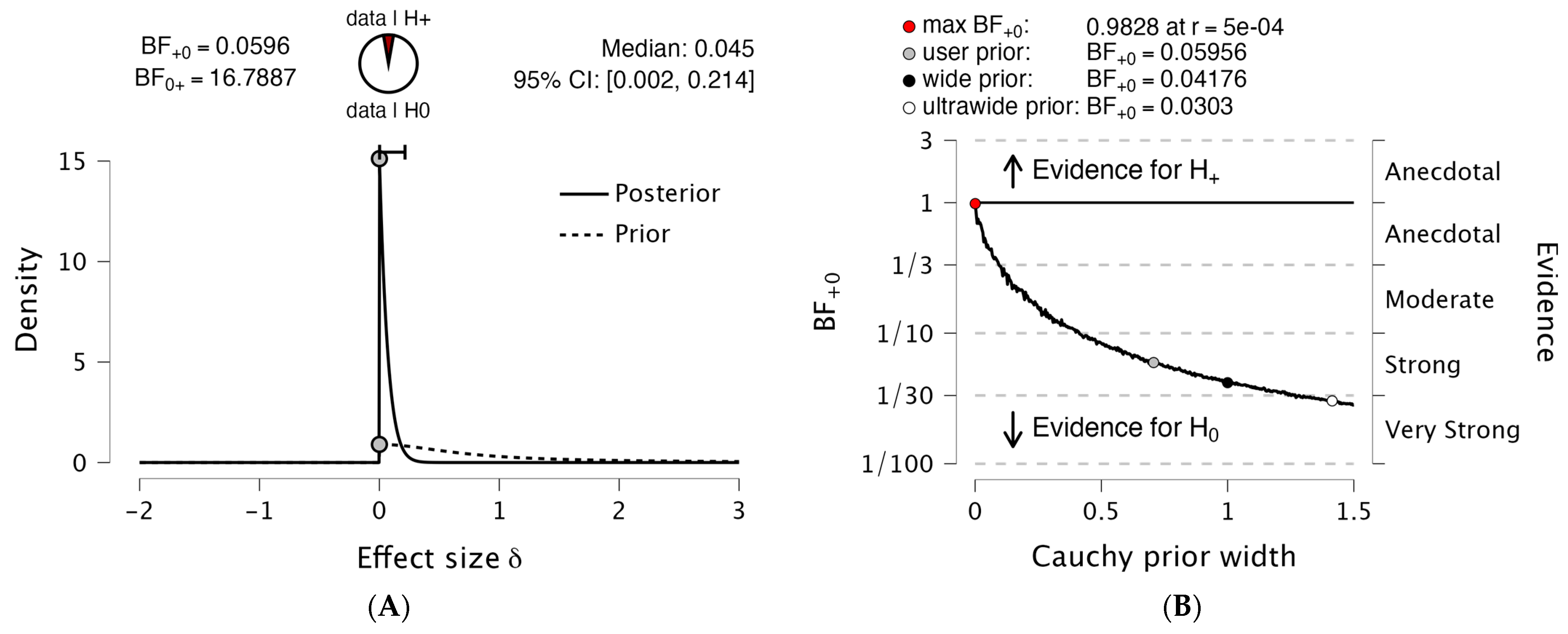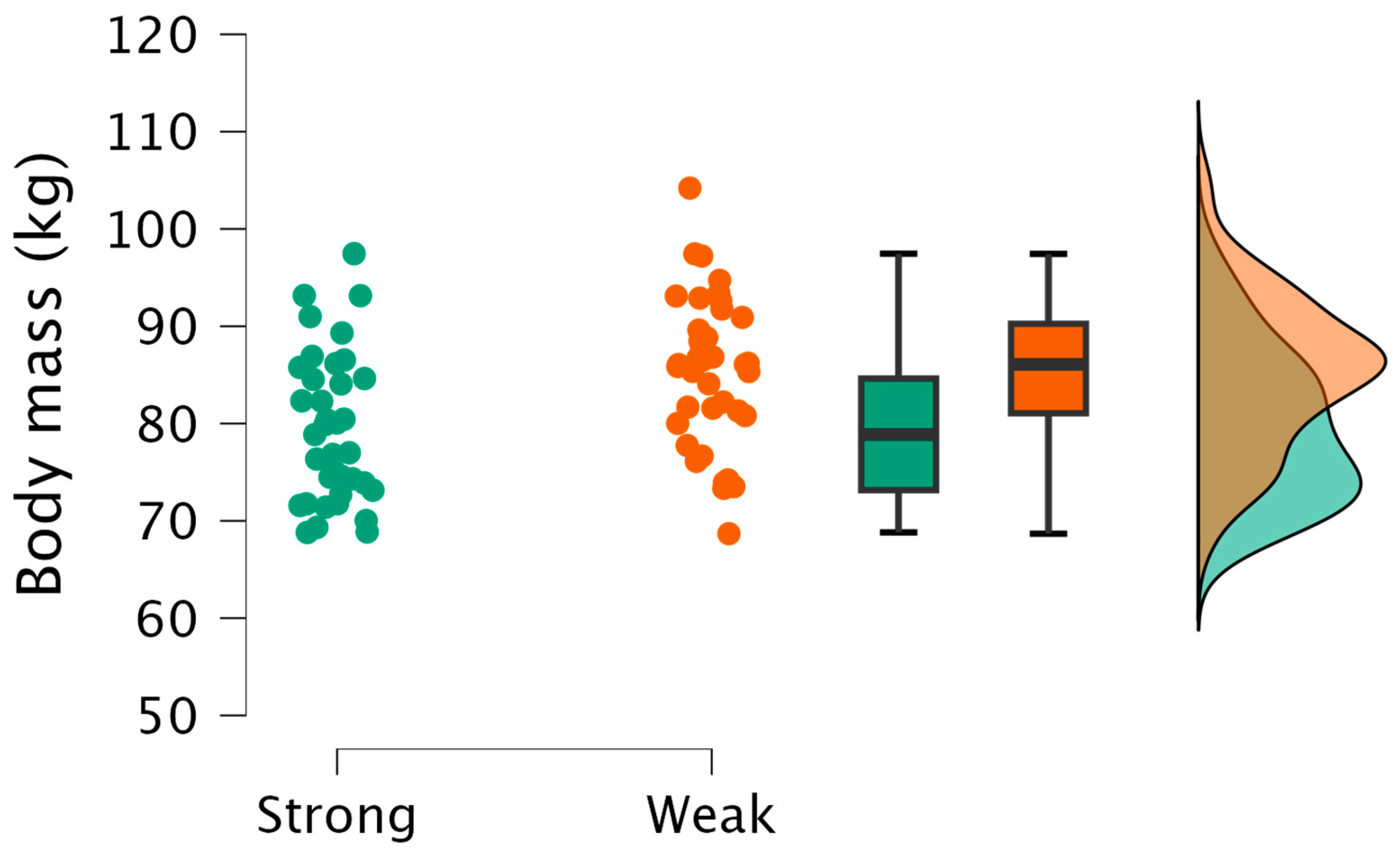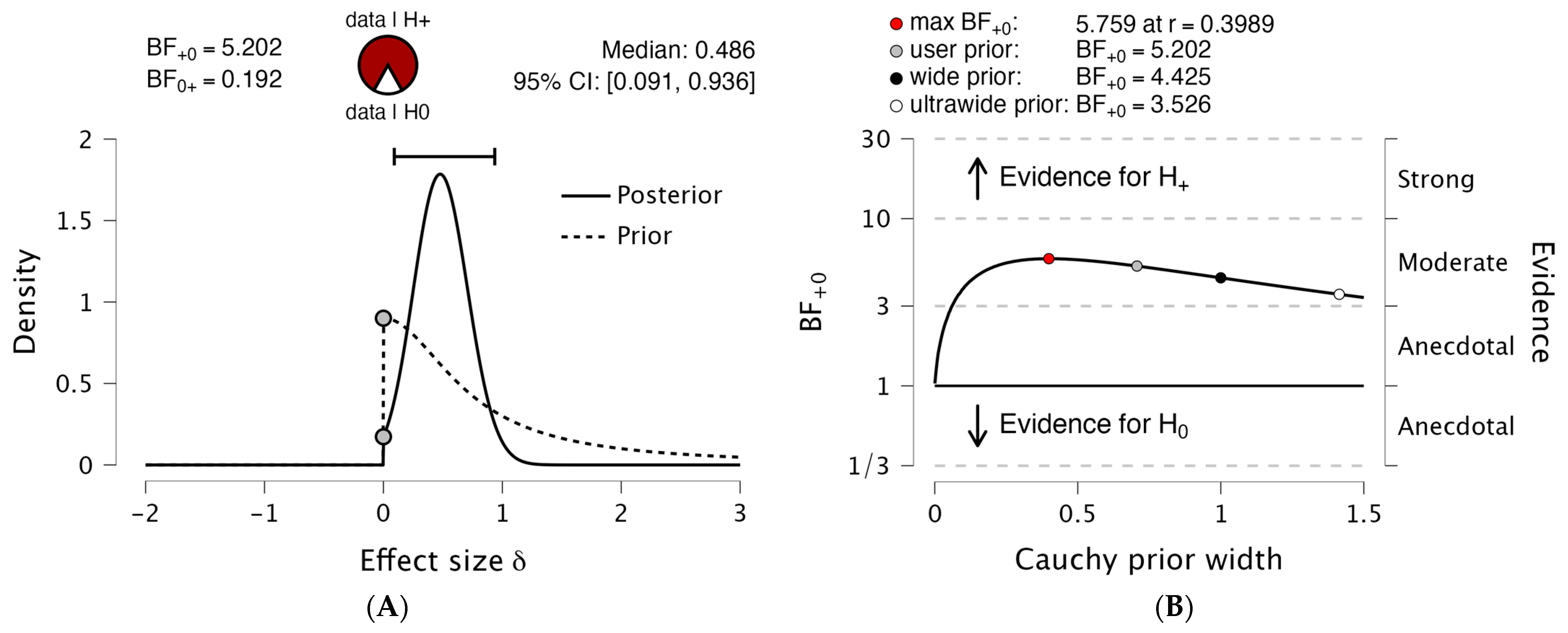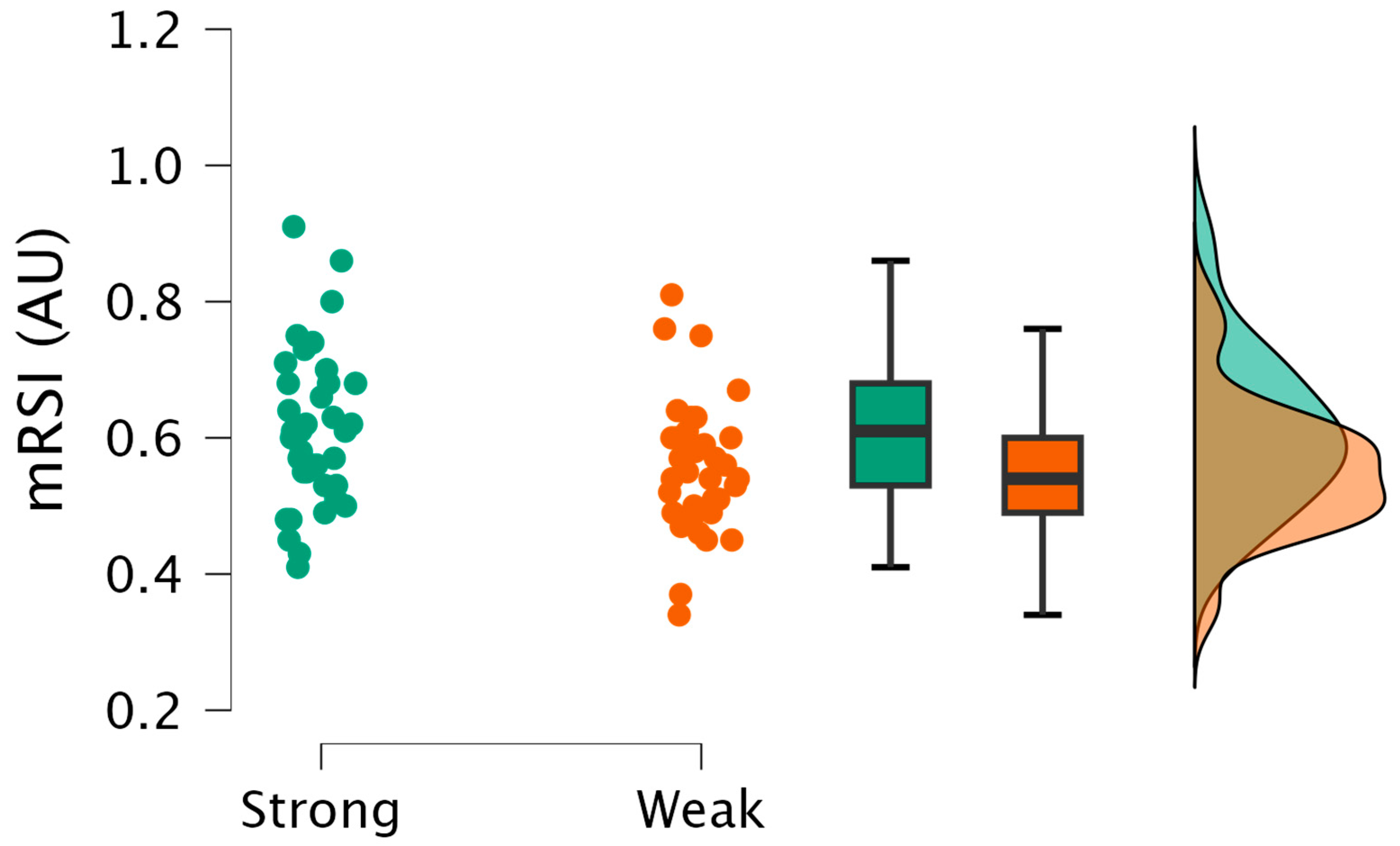Effect of Relative Isometric Strength on Countermovement Jump Performance in Professional and Semi-Professional Soccer Players
Abstract
1. Introduction
2. Materials and Methods
2.1. Experimental Setup
2.2. Participants
2.3. Procedures
2.4. Data Analyses
2.5. Statistical Analyses
3. Results
4. Discussion
5. Conclusions
Author Contributions
Funding
Institutional Review Board Statement
Informed Consent Statement
Data Availability Statement
Conflicts of Interest
Abbreviations
| IMTP | Isometric Mid-Thigh Pull |
| CMJ | Countermovement Jump |
| mRSI | Modified Reactive Strength Index |
| BF | Bayes Factor |
References
- Faude, O.; Koch, T.; Meyer, T. Straight sprinting is the most frequent action in goal situations in professional football. J. Sports Sci. 2012, 30, 625–631. [Google Scholar] [CrossRef] [PubMed]
- Martínez-Hernández, D.; Quinn, M.; Jones, P. Linear advancing actions followed by deceleration and turn are the most common movements preceding goals in male professional soccer. Sci. Med. Footb. 2023, 7, 25–33. [Google Scholar] [CrossRef] [PubMed]
- Martínez-Hernández, D.; Quinn, M.; Jones, P. Most common movements preceding goal scoring situations in female professional soccer. Sci. Med. Footb. 2024, 8, 260–268. [Google Scholar] [CrossRef] [PubMed]
- Stølen, T.; Chamari, K.; Castagna, C.; Wisløff, U. Physiology of Soccer. Sports Med. 2005, 35, 501–536. [Google Scholar] [CrossRef]
- Abe, T.; Fukashiro, S.; Harada, Y.; Kawamoto, K. Relationship between Sprint Performance and Muscle fascicle length in Female Sprinters. J. Physiol. Anthropol. 2001, 20, 141–147. [Google Scholar] [CrossRef]
- Alt, T.; Komnik, I.; Severin, J.; Nodler, Y.T.; Benker, R.; Knicker, A.J.; Brüggemann, G.-P.; Strueder, H. Swing phase mechanics of maximal velocity sprints—Does isokinetic thigh muscle strength matter? Int. J. Sports Physiol. Perform. 2020, 16, 974–984. [Google Scholar] [CrossRef]
- Comfort, P.; Bullock, N.; Pearson, S.J. A comparison of maximal squat strength and 5-, 10-, and 20-meter sprint times, in athletes and recreationally trained men. J. Strength Cond. Res. 2012, 26, 937–940. [Google Scholar] [CrossRef]
- Comfort, P.; Haigh, A.; Matthews, M.J. Are changes in maximal squat strength during preseason training reflected in changes in sprint performance in rugby league players? J. Strength Cond. Res. 2012, 26, 772–776. [Google Scholar] [CrossRef]
- Comfort, P.; Stewart, A.; Bloom, L.; Clarkson, B. Relationships between strength, sprint, and jump performance in well-trained youth soccer players. J. Strength Cond. Res. 2014, 28, 173–177. [Google Scholar] [CrossRef]
- Thomas, C.; Comfort, P.; Chiang, C.Y.; Jones, P.A. Relationship between isometric mid-thigh pull variables and sprint and change of direction performance in collegiate athletes. J. Trainology 2015, 4, 6–10. [Google Scholar] [CrossRef]
- Thomas, C.; Jones, P.A.; Rothwell, J.; Chiang, C.Y.; Comfort, P. An Investigation Into the Relationship Between Maximum Isometric Strength and Vertical Jump Performance. J. Strength Cond. Res. 2015, 29, 2176–2185. [Google Scholar] [CrossRef] [PubMed]
- Cronin, J.B.; Hansen, K.T. Strength and power predictors of sports speed. J. Strength Cond. Res. 2005, 19, 349–357. [Google Scholar] [CrossRef] [PubMed]
- Harper, D.; Cohen, D.D.; Rhodes, D.; Carling, C.; Kiely, J. Drop jump neuromuscular performance qualities associated with maximal horizontal deceleration ability in team sport athletes. Eur. J. Sport Sci. 2022, 22, 1005–1016. [Google Scholar] [CrossRef]
- Harper, D.; Cohen, D.D.; Carling, C.; Kiely, J. Can Countermovement Jump Neuromuscular Performance Qualities Differentiate Maximal Horizontal Deceleration Ability in Team Sport Athletes? Sports 2020, 8, 76. [Google Scholar] [CrossRef]
- Suchomel, T.J.; Nimphius, S.; Stone, M.H. The Importance of Muscular Strength in Athletic Performance. Sports Med. 2016, 46, 1419–1449. [Google Scholar] [CrossRef]
- McQuilliam, S.J.; Clark, D.R.; Erskine, R.M.; Brownlee, T.E. Global Differences in Current Strength and Conditioning Practice within Soccer. Int. J. Sports Sci. Coach. 2024, 19, 182–191. [Google Scholar] [CrossRef]
- Guthrie, B.; Jagim, A.; Jones, M.T. Ready or Not, Here I Come: A Scoping Review of Methods Used to Assess Player Readiness Via Indicators of Neuromuscular Function in Football Code Athletes. Strength Cond. J. 2023, 45, 93–110. [Google Scholar] [CrossRef]
- Weldon, A.; Duncan, M.J.; Turner, A.; Sampaio, J.; Noon, M.; Wong, D.P.; Lai, V.W. Contemporary practices of strength and conditioning coaches in professional soccer. Biol. Sport 2020, 38, 377–390. [Google Scholar] [CrossRef]
- Soriano, M.A.; Paredes, V.; Comfort, P.; Jiménez-Ormeño, E.; Areces-Corcuera, F.; Giráldez-Costas, V.; Gallo-Salazar, C.; Alonso-Aubín, D.A.; Menchén-Rubio, M.; McMahon, J.J. “You Are Not Wrong About Getting Strong:” An Insight Into the Impact of Age Group and Level of Competition on Strength in Spanish Football Players. Int. J. Sports Physiol. Perform. 2024, 19, 629–636. [Google Scholar] [CrossRef]
- Baker, D.G.; Newton, R.U. Comparison of lower body strength, power, acceleration, speed, agility, and sprint momentum to describe and compare playing rank among professional rugby league players. J. Strength Cond. Res. 2008, 22, 153–158. [Google Scholar] [CrossRef]
- Gabbett, T.; Kelly, J.; Pezet, T. Relationship between physical fitness and playing ability in rugby league players. J. Strength Cond. Res. 2007, 21, 1126–1133. [Google Scholar] [CrossRef] [PubMed]
- McMahon, J.; Murphy, S.; Rej, S.; Comfort, P. Countermovement-Jump-Phase Characteristics of Senior and Academy Rugby League Players. Int. J. Sports Physiol. Perform. 2017, 12, 803–811. [Google Scholar] [CrossRef] [PubMed]
- Comfort, P.; McMahon, J.J.; Lake, J.; Ripley, N.J.; Triplett, N.T.; Haff, G.G. Relative strength explains the differences in multi-joint rapid force production between sexes. PLoS ONE 2024, 19, e0296877. [Google Scholar] [CrossRef]
- Spencer, R.; Sindall, P.; Hammond, K.M.; Atkins, S.J.; Quinn, M.; McMahon, J.J. Changes in Body Mass and Movement Strategy Maintain Jump Height Immediately after Soccer Match. Appl. Sci. 2023, 13, 7188. [Google Scholar] [CrossRef]
- McMahon, J.; Suchomel, T.; Lake, J.; Comfort, P. Understanding the Key Phases of the Countermovement Jump Force-Time Curve. Strength Cond. J. 2018, 40, 96–106. [Google Scholar] [CrossRef]
- Bernards, J.R.; Sato, K.; Haff, G.G.; Bazyler, C.D. Current Research and Statistical Practices in Sport Science and a Need for Change. Sports 2017, 5, 87. [Google Scholar] [CrossRef]
- Mengersen, K.L.; Drovandi, C.C.; Robert, C.P.; Pyne, D.B.; Gore, J.C. Bayesian estimation of small effects in exercise and sports science. PLoS ONE 2016, 11, e0147311. [Google Scholar] [CrossRef]
- Lakens, D. Comment: What p-hacking really looks like: A comment on Masicampo and LaLande (2012). Q. J. Exp. Psychol. 2015, 68, 829–832. [Google Scholar] [CrossRef]
- Dos’Santos, T.; Thomas, C.; Comfort, P.; McMahon, J.J.; Jones, P.A. Relationships between Isometric Force-Time Characteristics and Dynamic Performance. Sports 2017, 5, 68. [Google Scholar] [CrossRef]
- Lum, D.; Haff, G.G.; Barbosa, T.M. The Relationship between Isometric Force-Time Characteristics and Dynamic Performance: A Systematic Review. Sports 2020, 8, 63. [Google Scholar] [CrossRef]
- Merrigan, J.J.; Stone, J.D.; Hornsby, W.G.; Hagen, J.A. Identifying Reliable and Relatable Force–Time Metrics in Athletes—Considerations for the Isometric Mid-Thigh Pull and Countermovement Jump. Sports 2020, 9, 4. [Google Scholar] [CrossRef] [PubMed]
- Badby, A.J.; Mundy, P.D.; Comfort, P.; Lake, J.P.; McMahon, J.J. The Validity of Hawkin Dynamics Wireless Dual Force Plates for Measuring Countermovement Jump and Drop Jump Variables. Sensors 2023, 23, 4820. [Google Scholar] [CrossRef] [PubMed]
- Merrigan, J.J.; Stone, J.D.; Galster, S.M.; Hagen, J.A. Analyzing Force-Time Curves: Comparison of Commercially Available Automated Software and Custom MATLAB Analyses. J. Strength Cond. Res. 2022, 36, 2387–2402. [Google Scholar] [CrossRef] [PubMed]
- Comfort, P.; Dos’Santos, T.; Beckham, G.K.; Stone, M.; Guppy, S.; Haff, G. Standardization and Methodological Considerations for the Isometric Midthigh Pull. Strength Cond. J. 2019, 41, 57–79. [Google Scholar] [CrossRef]
- Harry, J.R.; Blinch, J.; Barker, L.A.; Krzykowski, J.; Chowning, L. Low-Pass Filter Effects on Metrics of Countermovement Vertical Jump Performance. J. Strength Cond. Res. 2022, 36, 1459–1467. [Google Scholar] [CrossRef]
- van Doorn, J.; van den Bergh, D.; Böhm, U.; Dablander, F.; Derks, K.; Draws, T.; Etz, A.; Evans, N.J.; Granau, Q.F.; Haaf, J.M.; et al. The JASP guidelines for conducting and reporting a Bayesian analysis. Psychom. Bull. Rev. 2021, 28, 813–826. [Google Scholar] [CrossRef]
- Hopkins, W. A scale of magnitudes for effect statistics: A New View of Statistic. 2002. Available online: https://www.sportsci.org/resource/stats/effectmag.html (accessed on 4 May 2024).
- Cormie, P.; McGuigan, M.R.; Newton, R.U. Influence of strength on magnitude and mechanisms of adaptation to power training. Med. Sci. Sports Exerc. 2010, 42, 1566–1581. [Google Scholar] [CrossRef]
- Cormie, P.; McGuigan, M.R.; Newton, R.U. Adaptations in athletic performance after ballistic power versus strength training. Med. Sci. Sports Exerc. 2010, 42, 1582–1598. [Google Scholar] [CrossRef]
- Krzyszkowski, J.; Chowning, L.D.; Harry, J.R. Phase-Specific Predictors of Countermovement Jump Performance That Distinguish Good From Poor Jumpers. J. Strength Cond. Res. 2022, 36, 1257–1263. [Google Scholar] [CrossRef]
- Cormie, P.; McGuigan, M.R.; Newton, R.U. Changes in the eccentric phase contribution to improved stretch-shortening cycle performance after training. Med. Sci. Sports Exerc. 2010, 42, 1731–1744. [Google Scholar] [CrossRef]
- Hahn, D. On the phase definitions of counter movement jumps. Scand. J. Med. Sci. Sports 2023, 33, 359–360. [Google Scholar] [CrossRef] [PubMed]
- Linthorne, N. Analysis of standing vertical jumps using a force platform. Am. J. Phys. 2001, 69, 1198–1204. [Google Scholar] [CrossRef]
- Grgic, J.; Scapec, B.; Mikulic, P.; Pedisic, Z. Test-retest reliability of isometric mid-thigh pull maximum strength assessment: A systematic review. Biol. Sport 2022, 39, 407–414. [Google Scholar] [CrossRef]
- Guppy, S.N.; Brady, C.; Comfort, P.; Haff, G.G. The Isometric Mid-Thigh Pull: A Review & Methodology—Part 1. Prof. Strength Cond. 2018, 51, 13–19. [Google Scholar]
- Guppy, S.N.; Brady, C.; Comfort, P.; Haff, G.G. The Isometric Mid-Thigh Pull: A Review & Methodology—Part 2. Prof. Strength Cond. 2018, 51, 21–29. [Google Scholar]
- Nuzzo, J.L.; McBride, J.M.; Cormie, P.; McCaulley, G.O. Relationship between countermovement jump performance and multijoint isometric and dynamic tests of strength. J. Strength Cond. Res. 2008, 22, 699–707. [Google Scholar] [CrossRef]
- Wang, R.; Hoffman, J.R.; Tanigawa, S.; Miramonti, A.A.; La Monica, M.B.; Beyer, K.S.; Church, D.D.; Fukuda, D.H.; Jeffrey, S.R. Isometric Mid-Thigh Pull Correlates with Strength, Sprint and Agility Performance in Collegiate Rugby Union Players. J. Strength Cond. Res. 2016, 30, 3051–3056. [Google Scholar] [CrossRef]
- Suchomel, T.; Nimphius, S.; Bellon, C.R.; Stone, M.H. The Importance of Muscular Strength: Training Considerations. Sports Med. 2018, 48, 765–785. [Google Scholar] [CrossRef]
- Gabbett, T.J.; Jenkins, D.G.; Abernethy, B. Correlates of tackling ability in high-performance rugby league players. J. Strength Cond. Res. 2011, 25, 72–79. [Google Scholar] [CrossRef]
- Gabbett, T.J.; Seibold, A.J. Relationship between tests of physical qualities, team selection, and physical match performance in semiprofessional rugby league players. J. Strength Cond. Res. 2013, 27, 3259–3265. [Google Scholar] [CrossRef]
- Gabbett, T.J.; Stein, J.G.; Kemp, J.G.; Lorenzen, C. Relationship between tests of physical qualities and physical match performance in elite rugby league players. J. Strength Cond. Res. 2013, 27, 1539–1545. [Google Scholar] [CrossRef] [PubMed]
- Owen, A.; Dunlop, G.; Rouissi, M.; Chtara, M.; Paul, D.J.; Zouhal, H.; Wong, D.P. The relationship between lower-limb strength and match-related muscle damage in elite level professional European soccer players. J. Sports Sci. 2016, 33, 2100–2105. [Google Scholar] [CrossRef] [PubMed]
- Lauersen, J.B.; Bertelsen, D.M.; Andersen, L.B. The effectiveness of exercise interventions to prevent sports injuries: A systematic review and meta-analysis of randomised controlled trials. Br. J. Sports Med. 2014, 48, 871–877. [Google Scholar] [CrossRef] [PubMed]
- Sole, C.J.; Kavanaugh, A.A.; Reed, J.P.; Israetel, M.A.; Devine, L.E.; Ramsey, M.W.; Sands, W.A.; Stone, M.E. The Sport Performance Enhancement Group: A Five-Year Analysis of Interdisciplinary Athlete Development. In Proceedings of the 8th Annual Coaches and Sport Science College, Johnson City, TN, USA, 13–14 December 2013; pp. 28–30. [Google Scholar]






| Category | Metric |
|---|---|
| Person | Body mass (kg) |
| Outcome | Jump height (m) |
| Jump momentum (kg.m/s−1) | |
| mRSI (AU) | |
| Driver | Relative force at minimum displacement (N/kg) |
| Relative average braking force (N/kg) | |
| Relative average propulsive force (N/kg) | |
| Relative peak propulsive force (N/kg) | |
| Strategy | Countermovement depth (m) |
| Time to take off (s) |
| Metric | Mean ± SD | BF10 | Bayes Interpretation | Cohen’s d Effect Size (95% CI) |
|---|---|---|---|---|
| Body mass (kg) | Strong: 79.44 ± 7.65 Weak: 85.93 ± 7.66 | 0.060 | Strong Evidence h0 | −0.78 (−1.23 to −0.30) |
| Jump height (m) | Strong: 0.39 ± 0.05 Weak: 0.38 ± 0.06 | 1.040 | Weak evidence h1 | 0.33 (−0.13 to 0.78) |
| Jump momentum (kg.m/s−1) | Strong: 220.44 ± 25.38 Weak: 231.57 ± 27.11 | 0.091 | Weak evidence h0 | −0.42 (−0.87 to 0.04) |
| mRSI (AU) | Strong: 0.61 ± 0.12 Weak: 0.55 ± 0.09 | 5.202 | Moderate evidence h1 | 0.54 (0.08 to 1.00) |
| Relative force at minimum displacement (N/kg) | Strong: 27.73 ± 3.67 Weak: 26.11 ± 4.13 | 1.819 | Weak evidence h1 | 0.41 (−0.05 to 0.86) |
| Relative average braking force (N/kg) | Strong: 20.80 ± 2.39 Weak: 19.37 ± 2.65 | 6.017 | Moderate evidence h1 | 0.56 (0.10 to 1.02) |
| Relative average propulsive force (N/kg) | Strong: 22.67 ± 2.28 Weak: 21.83 ± 2.38 | 1.272 | Weak evidence h1 | 0.36 (−0.10 to 0.81) |
| Relative peak propulsive force (N/kg) | Strong: 28.53 ± 3.71 Weak: 27.21 ± 4.47 | 0.992 | Weak evidence h0 | 0.32 (−0.14 to 0.77) |
| Countermovement depth (m) | Strong: −0.28 ± 0.06 Weak: −0.29 ± 0.07 | 0.346 | Weak evidence h0 | 0.10 (−0.35 to 0.55) |
| Time to take off (s) | Strong: 0.66 ± 0.09 Weak: 0.70 ± 0.11 | 1.376 | Weak evidence h1 | −0.37 (−0.82 to 0.09) |
Disclaimer/Publisher’s Note: The statements, opinions and data contained in all publications are solely those of the individual author(s) and contributor(s) and not of MDPI and/or the editor(s). MDPI and/or the editor(s) disclaim responsibility for any injury to people or property resulting from any ideas, methods, instructions or products referred to in the content. |
© 2025 by the authors. Licensee MDPI, Basel, Switzerland. This article is an open access article distributed under the terms and conditions of the Creative Commons Attribution (CC BY) license (https://creativecommons.org/licenses/by/4.0/).
Share and Cite
Ripley, N.J.; Fahey, J.; Hassim, N.; Comfort, P. Effect of Relative Isometric Strength on Countermovement Jump Performance in Professional and Semi-Professional Soccer Players. Biomechanics 2025, 5, 32. https://doi.org/10.3390/biomechanics5020032
Ripley NJ, Fahey J, Hassim N, Comfort P. Effect of Relative Isometric Strength on Countermovement Jump Performance in Professional and Semi-Professional Soccer Players. Biomechanics. 2025; 5(2):32. https://doi.org/10.3390/biomechanics5020032
Chicago/Turabian StyleRipley, Nicholas Joel, Jack Fahey, Nabil Hassim, and Paul Comfort. 2025. "Effect of Relative Isometric Strength on Countermovement Jump Performance in Professional and Semi-Professional Soccer Players" Biomechanics 5, no. 2: 32. https://doi.org/10.3390/biomechanics5020032
APA StyleRipley, N. J., Fahey, J., Hassim, N., & Comfort, P. (2025). Effect of Relative Isometric Strength on Countermovement Jump Performance in Professional and Semi-Professional Soccer Players. Biomechanics, 5(2), 32. https://doi.org/10.3390/biomechanics5020032







